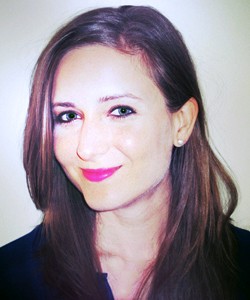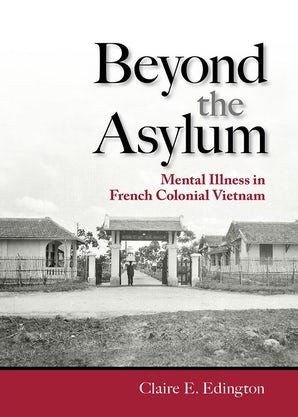WEAI Author Q&A: Claire E. Edington’s “Beyond the Asylum: Mental Illness in French Colonial Vietnam”

We are excited to announce a new title in the Studies of the Weatherhead East Asian Institute book series: Beyond the Asylum: Mental Illness in French Colonial Vietnam published by Cornell University Press. The book’s author is Claire E. Edington, an Assistant Professor of History at the University of California, San Diego. Dr. Edington was the winner of the Weatherhead East Asian Institute’s 2019 First Book Prize and the Jack D. Pressman-Burroughs Wellcome Fund Career Development Award in 20th Century History of Medicine or Biomedical Sciences for Beyond the Asylum.
Claire Edington’s fascinating look at psychiatric care in French colonial Vietnam challenges our notion of the colonial asylum as a closed setting, run by experts with unchallenged authority, from which patients rarely left. She shows instead a society in which Vietnamese communities and families actively participated in psychiatric decision-making in ways that strengthened the power of the colonial state, even as they also forced French experts to engage with local understandings of, and practices around, insanity. Beyond the Asylum reveals how psychiatrists, colonial authorities, and the Vietnamese public debated both what it meant to be abnormal, as well as normal enough to return to social life, throughout the early twentieth century.
Straddling the fields of colonial history, Southeast Asian studies and the history of medicine, Beyond the Asylum shifts our perspective from the institution itself to its relationship with the world beyond its walls. This world included not only psychiatrists and their patients, but also prosecutors and parents, neighbors and spirit mediums, as well as the police and local press. How each group interacted with the mentally ill, with each other, and sometimes in opposition to each other, helped decide the fate of those both in and outside the colonial asylum.
We thank Dr. Edington for taking the time to discuss her book with us. Please read the following Q&A to learn more about the research and questions that propelled her project.

Can you describe your research?
My research examines the way medical experts, state institutions, and popular beliefs shaped the lives of the mentally ill in Vietnam throughout the late 19th and early 20th centuries. I am centrally interested in how ideas about deviance and disease travel across cultures and what everyday exchanges between lay people and experts can tell us about the social history of Vietnam. Drawing on hundreds of patient case files from two asylums built by the French in what is now Vietnam, I follow the movements of patients in and out of asylums and between prisons, poor houses, youth reformatories, hospitals and family homes. Together, these individual patient itineraries challenge our notion of the colonial asylum as a closed setting where patients rarely left, run by experts who enjoyed broad and unquestioned authority. Instead they reveal just how porous the boundaries between the asylum and community could be.
So rather than place the asylum at the front and center of the story, each chapter of my book instead examines the relationship between the asylum and community from a different point of view. Starting with early colonial debates over extending the famous 1838 French asylum law to Indochina, the book gradually expands its focus from the discourse around mental illness to the daily practices of the asylum itself and then on to its interactions with the complex social world outside its doors. In this way, the book progresses as a series of concentric circles radiating outward from the asylum, considering the history of mental illness from multiple and widening perspectives, from the intimate space of the Vietnamese household to the courtroom spectacle of the murder trial. At the same time, the book is organized roughly chronologically, as a way to chart social change in Vietnam, as well as global shifts in psychiatric knowledge and colonial policy, from 1880 to about 1940.
How did you work lead you to write about mental illness in French colonial Vietnam?
I’ve always been interested in people on the margins, and what their stories can tell us about how as a society we think about and manage human difference. My interest in Vietnam developed after I arrived at the PhD program in the History and Ethic of Public Health (Department of Sociomedical Sciences) at Columbia University. The Mailman School of Public Health had recently developed a partnership with Hanoi Medical University, and Dr. Jennifer Hirsch invited me to join the initiative. I had long been interested in the history of the French empire, and colonial Southeast Asia remains relatively understudied, at least among historians of medicine. My first trip to Vietnam was a revelation; I quickly fell in with the history, culture and people, and never looked back.
What were some of the differences between French and Vietnamese mindsets on mental illness during the late 19th century? What was considered normal versus abnormal?
Understandings about mental illness in Vietnam bear the marks of several philosophical and epistemic systems: Buddhism, Confucianism, Taoism, and Western biomedicine. Naturalistic or folk medicine, supernatural or animistic beliefs, and metaphysical explanations or Chinese hot/cold theory also play important roles. The particular influence of traditional Chinese medicine can be seen in the holistic notion of physical and mental health: emotional states are closely tied to physical disturbances and vice versa. Whereas Western biomedicine defines health as the absence of illness, in Vietnamese culture health is achieved by the continual maintenance of balance between external and internal, physical and moral forces. This holistic or integrative notion of health does not fit neatly within the particular mind-body dichotomy found in Western conceptions.
What might surprise readers is how often Vietnamese families agreed with French doctors about the presence of mental illness, especially for those patients suffering from more severe disorders. They often disagreed, however, on how to explain the origins of the affliction and what should be done about it. The cultural content of mental illness itself—how symptoms of psychiatric distress were experienced and expressed by patients and how they were interpreted by those closest to them—also posed serious challenges for colonial doctors who insisted on diagnosing disorders based on classification schemes developed in France. While the categories of normal and abnormal continued to be framed in Western terms, the content of these categories critically relied on the kinds of information Vietnamese were willing or thought relevant to tell French doctors.
How did Western and Southeast Asian medicines or treatment for mental illness differ from each other?
In their everyday lives, the patients of Vietnamese families most likely drew on a range of influences in the pursuit of treatment: Chinese notions of qi alongside homegrown “southern” aka Vietnamese medicine, with its emphasis on local pharmacopeia, as well as the work of indigenous healers such as fortune-tellers and spirit mediums, Buddhist monks and Taoist priests. Throughout the interwar years, Vietnamese families increasingly resorted to institution-based mental health care when traditional healers did not work, or in the event of the failure of asylum care, recommenced the search for alternative therapies. Vietnamese families sought the care of both local and foreign experts but they also asked for advice on home remedies in the pages of popular medical journals that emerged in the 1920s and 30s as part of Indochina’s vibrant press culture. This public sphere played host to a new marketplace for ideas about mental illness—from melodramas about suicide and broken hearts to advice columns which allowed concepts that in scientific language might be too difficult and abstract for the common reader to be recast in the form of confessions and expert response. Whereas colonial French sources tended to dismiss traditional Vietnamese medicine as quack or non-scientific, these Vietnamese-language journals provided a space where Western-trained Vietnamese doctors could communicate with each other and the public. Rather than cast aside indigenous explanatory models of illness, these authors explicitly drew on local conceptions of health and disease in order to reach the average reader.
How did the asylum fit into Vietnamese society?
Colonial asylum directors could not and did not operate in isolation. Their reliance on the public to not only present patients for treatment but also to take care of patients upon their return home meant they were continually forced to negotiate the terms of patient entry and release. At every turn, asylum administrators in interwar Indochina were beset with the challenges of failed surveillance and interpersonal violence produced by patient overcrowding, diminishing budgets, and problems with staff recruitment and retention, which only deepened their dependency on extra-institutional forms of support. Vietnamese families, meanwhile, pursued their own strategies in ways that both facilitated and constrained the ambitions of colonial psychiatrists. In some instances, families eagerly solicited the services of state-run institutions and in others, attempted to shield family members as much as possible from the outside world. The arrival of asylums may have marked the beginning of psychiatry as a state-sponsored project in Vietnam, but it was inserted into a pre-existing field of knowledge and practice that it never fully succeeded in displacing.
Did you encounter challenges during your research or writing?
When I first visited the National Archives of Vietnam in Hanoi in 2008, I discovered what proved to be an amazing archive of hundreds of patient case files from two asylums built by the French—the first outside Saigon in 1919, the second, in the north, outside Hanoi in 1934. I was handed patient case files as if they were any other kind of bureaucratic paperwork produced by the French colonial health service. Now it’s clear that patient case files are not just like any other kind of paper work—instead they enjoy a protected status. Privacy legislation in the US typically restricts access to records 100 years old and less that contain personal information. I want to emphasize, however, that the conditions for accessing the archive in the first place were quite stringent—a research visa was required (and not easy to obtain) and I provided documentation of official sponsorship from my local host institution, Hanoi Medical University. I also supplied a letter of intent describing my research project and every document I asked to see was approved through three different ladders in the archives hierarchy. Finally, I was generally not allowed to photograph and the staff would photocopy only sections of dossiers after another lengthy review process.
So while the patient case files I discovered may not have enjoyed protected status, the archive as a whole did. And its protection was motivated by a different set of concerns about how to best monitor the work of foreign researchers and their uses of Vietnamese history for political ends. I was lucky I worked on colonial period—any work on the 1950s later, especially political histories, not surprisingly—are much more policed. When I returned to the United States, I initiated an IRB approval process which retrospectively granted my project an exemption status for human subjects research. As an extra precaution, I anonymized all patient names.
My experience reflects a pretty common story about how decisions about access and the representation of patient experiences get made: as the result of a mixture legal restrictions, professional conventions and unwritten ethical obligations. Because legal norms are uneven across the globe, and colonial archives might not be subject to the same standards as institutional archives, this puts even greater weight on the discretion of the researcher to ensure protections of patient information and privacy.
